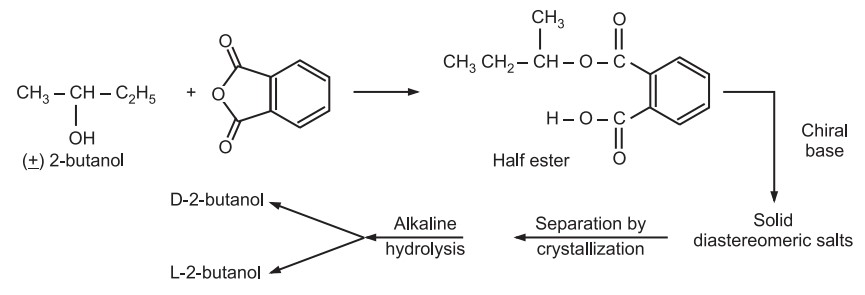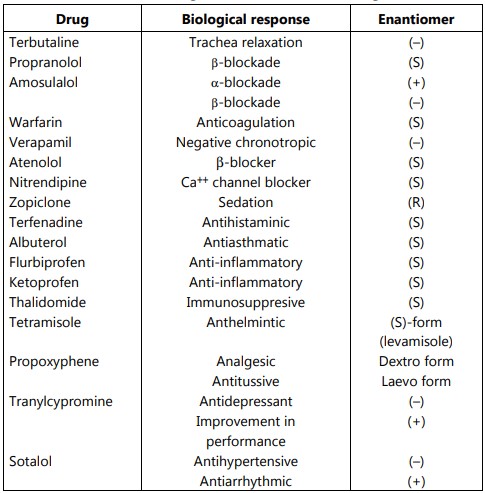A racemic modification, also known as a racemate, is a mixture of (+) and (–) enantiomers in a 1:1 ratio. When equal amounts of enantiomers are combined together, the rotation induced by one isomer’s molecule is perfectly neutralized by an equal and opposite rotation caused by its enantiomer’s molecule. As a result, the racemate’s overall optical rotation is zero. As a result, a racemic alteration is optically inactive. The prefix (±) is used to denote the racemic nature of the sample. e.g., (±)-2-methyl-1-butanol.
When one of the starting materials is chiral, the product of the reaction will always be formed as a racemate in the absence of a chiral catalyst.

However, biologically active pure enantiomer can be synthesized in the presence of chiral catalysts or agents.
Methods of Racemic Modification
(a) Mixing: A racemic modification may be achieved by intimate mixing of exactly equal amounts of dextro (+) and levo (–) isomers.
(b) Chemical synthesis: When one of the starting materials is chiral the product of the reaction will always be formed as a racemate in the absence of a chiral catalyst. e.g., when hydrogen cyanide reacts with acetaldehyde (chiral), equal number of mole of two enantiomeric forms of lactonitrile, CH3CHOHCN results.
(c) Thermal racemization: Racemization may occur when an optically active material is heated. It leads to temporarily breaking one of the 4 bonds to a stereocenter. The atom/group separated exchanges the position and joins back to the stereocenter to form another enantiomer e.g., the distillation of optically active enantiomer of α-phenethyl chloride leads to its racemization.
(d) Walden inversion: The racemization of 2-iodooctane by potassium iodide in refluxing acetone involves a process known as Walden inversion.
(e) Epimerization: It is the change in the configuration at one asymmetric carbon atom in a compound having more than one stereocenter. It thus leads to the interconversion of diastereomers.
(f) Mutarotation: It is a spontaneous change with time, in the rotation of freshly prepared solutions of optically active substance till it reaches an equilibrium. Mutarotation is the result of either epimerization or a spontaneous structural change. The rate of mutarotation depends on temperature, solvent, and catalyst. For example, the mutarotation of glucose is known to be acid-base catalyzed.
Resolution of Racemic Mixture
Resolution is the process of separating a racemate into pure enantiomers. Because enantiomers have identical physical properties (b.p., m.p., and solubility), it is impossible to distinguish them using traditional methods. When a pair of enantiomers is turned into a pair of diastereomers, the diastereomers can be easily differentiated due to their physical differences. The pure enantiomer can be regenerated from its respective diastereomer once it has been separated.
For example,
(i) A racemic mixture of enantiomers of an acid can be converted to a salt using a chiral base having D-configuration. The salt obtained contains a mixture of two diastereomers: (D acid, D base) and (L acid, D base). Due to difference in their physical properties, the diastereomeric salts are fully separated. Dissociation of separated diastereomeric salt leads to regeneration of D-acid and L-acid respectively.

Racemic acids may be resolved using commercially available chiral bases like brucine, strychnine, and l-phenyl ethanamine. Similarly, racemic bases may be resolved using chiral acids such as (+) tartaric acid, (–) malic acid, (–) mandelic acid, and (+) camphoric acid.
Racemic alcohol may be resolved by converting the racemate into a mixture of diastereomeric esters using a chiral acid. The separation of these diastereomeric esters becomes difficult if they are liquid. In such cases, instead of full ester, the half ester is synthesized containing one free carboxylic group. A chiral base, brucine then forms solid diastereomeric salts which can be later separated by crystallization. The pure enantiomer of 2-butanol is regenerated through hydrolysis of respective diastereomeric salt.

(ii) Resolution by biochemical means: Certain mold, bacteria or fungi selectively destroy one enantiomer at a faster rate than the other enantiomer. For example, the mold Penicillium glaucum if allowed to grow with a racemic mixture, it selectively destroys the dextro isomer leaving pure Levo isomer behind.

Advantages of Resolution:
(i) To avoid side effects of unwanted enantiomer leading to improved therapeutic profile, and fewer chances of a drug interaction.
(ii) Reduction in the therapeutic dose and hence the cost of treatment.
(iii) Lesser metabolic, renal and hepatic load of a drug on the body as the dose (for a pure enantiomer) reduces to half of the racemic mixture.
Also read: Elements of symmetry